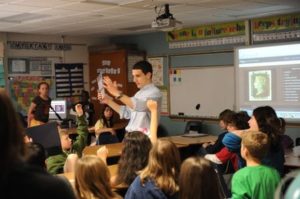Student Contributor: C. Hernandez
 Proximity interference is when the teacher moves closer to a student who is beginning to get off-task. This tool can be helpful because they are not disruptive to the rest of the class.
Proximity interference is when the teacher moves closer to a student who is beginning to get off-task. This tool can be helpful because they are not disruptive to the rest of the class.
Proximity interference is when the teacher during instruction gets near to their students that are getting off task or misbehaving. The teacher can use proximity at any grade level. When a student is beginning to get off-task and the student does not notice your eye contact right away, proximity is the next response. Moving near the misbehaving student is a tool that will help when you cannot get the students attention because people usually notice movement. Proximity interference doesn’t disrupt the lesson or remove the attention from the class. It works well because they are private, personal, and they are seen by one or two students whom it is attended to. This tool can also be useful for when the students are in groups or in seat work to ensure that they are on task and not disrupting others.
 Proximity interference relates to the corrective phase because this strategy helps correct the student’s behavior. Moving closer to the students keeps the teacher from having to call out students verbally. The reason for this is because usually just moving close the students will correct the student’s behavior. Proximity can relate to the preventative phase because this tool can be used to prevent disruptive behavior. Although, it best fits with corrective because it is used after the fact, meaning that the student has already began to get off task. Proximity interference best relates to student directed and collaborative because it is moving close to the student that allows the student to self-correct their behavior, improve their focus, and to engage on a task.
Proximity interference relates to the corrective phase because this strategy helps correct the student’s behavior. Moving closer to the students keeps the teacher from having to call out students verbally. The reason for this is because usually just moving close the students will correct the student’s behavior. Proximity can relate to the preventative phase because this tool can be used to prevent disruptive behavior. Although, it best fits with corrective because it is used after the fact, meaning that the student has already began to get off task. Proximity interference best relates to student directed and collaborative because it is moving close to the student that allows the student to self-correct their behavior, improve their focus, and to engage on a task.
More Information –
Tool Source: I got the idea of proximity interference from Digiulio’s article, “Managing a smooth-running classroom”.



1st grade/20 students/urban
Before reading too far into this tool, I had been doing it without realizing what I was doing. I find it to be a teacher’s instinct to move toward a student who is off task. Just your presence there is a hint to students to get back to what they are expected to be doing. In my classroom, I have noticed great success in using this tool. In the school that I am placed at we use a software program for math and reading. I noticed that one of my students had the window closed and was sitting doing nothing. I went and stood behind him, and as soon as he was aware of my presence, he got right back on to what he was supposed to be doing. I didn’t have to say a word. I think the students understood what I was doing, even if they weren’t aware that they do. The only thing I would say to add is how long do you stay in proximity to the student before you step in and say something? I have experience of waiting too long and my mentor teacher had to step in, as well as not waiting long enough for them to figure it out on their own. Overall, this is a great addition to the website!
I implemented Proximity Interference in my 8th-grade math classroom, with 15-25 students each period, located in an urban area. This tool was especially easy to implement, as it is something that I did naturally to help with off-task behaviors. I even could implement this tool when I was not the one conducting the lesson and was observing/assisting my mentor teacher. It was also very age-appropriate and was natural for our classroom. I especially liked how non-disruptive this was, as I did not have to rely on only using verbal correction strategies. I noticed that when I was mindfully using this tool, students partaking in off-task behaviors (most specifically talking while the teacher is talking) would re-focus. My students understood their role in this tool, as they knew that if I was approaching them, they needed to correct their behavior. One thing that I would add to this tool would be to have another tool or strategy mentally prepared beforehand, in the case that students do not pick up on it. Overall, I think this is a great strategy for all grade levels!